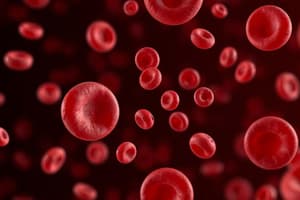Podcast
Questions and Answers
Which of the following is a classification of anemia based on the etiologic factor?
Which of the following is a classification of anemia based on the etiologic factor?
- Normocytic
- Macrocytic
- Microcytic
- Normochromic (correct)
What is the hemoglobin range for males according to the text?
What is the hemoglobin range for males according to the text?
- 41-50%
- 12-15.5 g/dL
- 78-100 femtoliter
- 13.5-17 g/dL (correct)
Which mechanism can lead to acquired hemolysis?
Which mechanism can lead to acquired hemolysis?
- Hereditary hemolysis
- Blood transfusion reaction (correct)
- Increased erythrocyte production
- Sickle cell disease
What is the term used for RBCs that are present in various shapes?
What is the term used for RBCs that are present in various shapes?
What are the clinical manifestations of hypoxia due to reduced O2-carrying capacity in anemia?
What are the clinical manifestations of hypoxia due to reduced O2-carrying capacity in anemia?
What is the cause of normocytic anemia according to the text?
What is the cause of normocytic anemia according to the text?
What is the normal range for RDW according to the information provided?
What is the normal range for RDW according to the information provided?
Which term is used to identify RBCs that are abnormally small and contain reduced amounts of hemoglobin?
Which term is used to identify RBCs that are abnormally small and contain reduced amounts of hemoglobin?
What are the classic symptoms/signs of anemia mentioned in the text?
What are the classic symptoms/signs of anemia mentioned in the text?
What are the terms used to identify RBCs based on their size and hemoglobin content?
What are the terms used to identify RBCs based on their size and hemoglobin content?
What is the most common physiologic cause of iron deficiency anemia in women?
What is the most common physiologic cause of iron deficiency anemia in women?
What is the average menstrual flow for women, and how much can it vary by?
What is the average menstrual flow for women, and how much can it vary by?
Which test is the most sensitive for diagnosing iron deficiency anemia?
Which test is the most sensitive for diagnosing iron deficiency anemia?
What is the main pathophysiologic cause of iron deficiency anemia?
What is the main pathophysiologic cause of iron deficiency anemia?
Which demographic has the highest risk for iron deficiency anemia?
Which demographic has the highest risk for iron deficiency anemia?
What is the measure of available transferrin left unbound to iron called?
What is the measure of available transferrin left unbound to iron called?
Which of the following is a common disorder affecting iron metabolism?
Which of the following is a common disorder affecting iron metabolism?
Flashcards are hidden until you start studying
Study Notes
Types of Anemia
- Anemia is classified based on etiological factors: such as blood loss, hemolysis, and inadequate production.
Hemoglobin Levels
- Normal hemoglobin range for males: 13.5 to 17.5 grams per deciliter (g/dL).
Acquired Hemolysis Mechanisms
- Acquired hemolysis can result from autoimmune diseases, infections, or chemical exposure.
Red Blood Cell Shape Abnormalities
- The term "poikilocytosis" describes red blood cells that exhibit various shapes.
Clinical Manifestations of Anemia
- Hypoxia-related symptoms include fatigue, weakness, pallor, shortness of breath, and increased heart rate.
Normocytic Anemia Causes
- Common causes of normocytic anemia include chronic disease and acute blood loss.
Red Cell Distribution Width (RDW)
- Normal RDW range is typically between 11.5% and 14.5%.
Microcytic Anemia Terminology
- "Microcytic anemia" identifies red blood cells that are abnormally small and contain decreased hemoglobin.
Classic Symptoms of Anemia
- Classic signs include fatigue, paleness, dizziness, and increased heart rate.
Red Blood Cell Classification Terms
- Red blood cells are categorized by size (microcytic, normocytic, macrocytic) and hemoglobin content (hypochromic, normochromic).
Iron Deficiency Anemia in Women
- The most common physiological cause is menstrual blood loss.
Average Menstrual Flow
- Average menstrual flow is about 30 to 80 mL per cycle, with variability up to 50 mL.
Diagnosis of Iron Deficiency Anemia
- Serum ferritin test is the most sensitive indicator for diagnosing iron deficiency anemia.
Pathophysiologic Cause of Iron Deficiency Anemia
- The primary cause is insufficient iron intake or absorption.
Demographic at Highest Risk
- Women of reproductive age are at the highest risk for developing iron deficiency anemia.
Transferrin Measurement
- The measure of unbound transferrin that is available for iron binding is termed "transferrin saturation."
Common Iron Metabolism Disorder
- Iron overload disorders, such as hemochromatosis, are frequent conditions that affect iron metabolism.
Studying That Suits You
Use AI to generate personalized quizzes and flashcards to suit your learning preferences.




